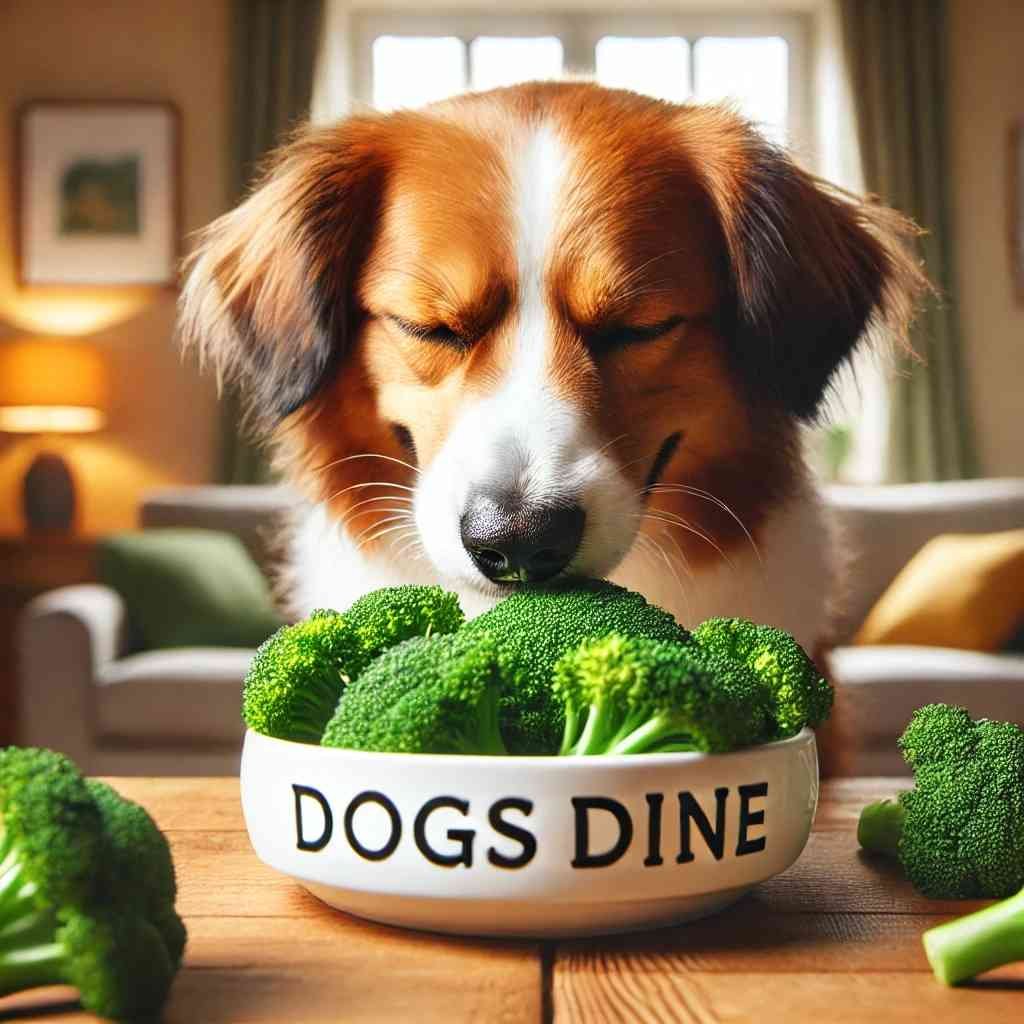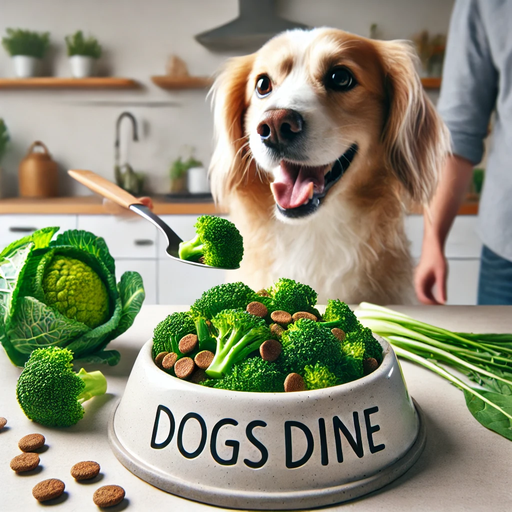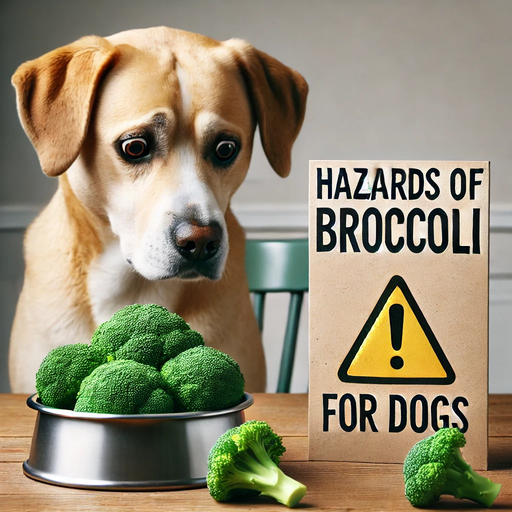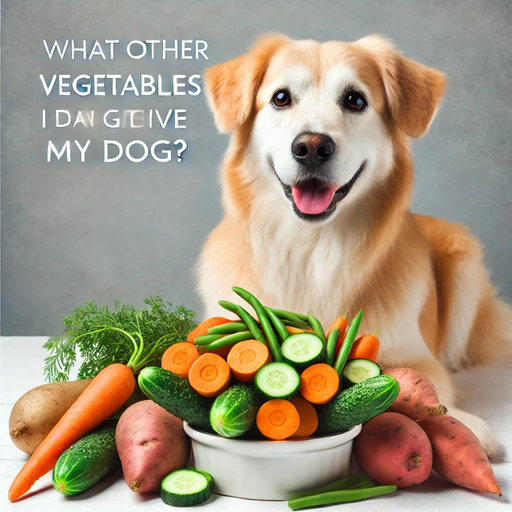
Can Dogs Eat Broccoli Rabe? The answer is Yes, If you’re curious about giving your dog a new treat, you might have got some broccoli rabe in your veggie drawer. While this vegetable is considered safe for humans, it should be fed to dogs with care. When eaten in large amounts, especially raw, it can be harmful due to the isothiocyanates found in the florets, which may cause gastric irritation.
However, when cooked and served in small quantities, it can offer tons of beneficial qualities like supporting liver detoxification, fighting cancer, strengthening bones, and promoting a healthy heart. Pet parents looking for a healthy addition to their dog’s diet should first contact a veterinarian before introducing broccoli rabe to avoid any digestive upset, diarrhea, or loose stools.
A good choice for overweight dogs, broccoli rabe is high in fiber, antioxidants, and vitamins while being low in calories. It’s best to chop it into pieces, steam or microwave, and mix with kibble, slowly increasing the amount to watch for any reactions. Since broccoli rabe doesn’t taste like Brussels sprouts, your pooch may need time to adjust.
Always serve it plain, fresh, and without seasonings or oils added to ensure it remains a nutritious option in their dinner bowl. While introducing new foods, it’s also important to monitor your dog’s digestion. If you ever notice unusual stool changes, such as a foul, greasy odor, you might wonder, What Does Giardia Poop Smell Like in Dogs? This can be a sign of a Giardia infection, which requires veterinary attention.
How Is Broccoli Rabe Good For Dogs?
Broccoli rabe is a nutrient-richveggie that belongs to the cabbage family and has a distinct flavor that some dogs enjoy. An added bonus is that it supplies your pup with essential vitamins and minerals, making it a healthy treat.
It is high in folates, also known as vitamin B9 or folic acid, which are important for cell growth and proper function. This veggie can also aid in boosting your dog’s immune system with its rich content of vitamins A, C, and E.
Additionally, it is loaded with vitamin K, which is essential for blood clotting and helps your pup in situations where they need to sustain a cut or support scabbing and healing. To get the best benefits, consider feeding it on occasion and in small portions, around one or two times a week.
Get your furry friend covered
Feeding your dog broccoli rabe can be a wonderful treat that supports their overall health. This leafy green is rich in Vitamin K, which is essential to help your pupsynthesize proteins needed for blood clotting.
If a dog ingests rat poison, having enough Vitamin K in their system can prevent internal bleeding and ensure they are treated swiftly.
While broccoli rabe can be a healthy addition, it should always be given in moderation to keep your four-legged friend safe and happy.
How Can I Safely Give Broccoli Rabe To My Dog?

If you want to give your dog broccoli rabe, it’s important to prepare it properly to keep it safe and nutritious. Dogs should not eat it raw because it contains high levels of goitrogen, which can lead to hypothyroidism if consumed in large amounts.
Instead, it should be cooked by methods such as steaming, blanching, or sautéing without any oils or spices, which can be harmful to your doggo. Always chop the leaves into smaller pieces, as dogs’ digestive systems are not well equipped to digest the whole vegetable like a human.
You can include it in their normal meal as a healthy addition to their diet or serve it as a special treat during a fancy dinner. For a fun twist, try baking it into a crispy leaf without peppering to make it a crunchy snack.
Remember to feed in moderation, and if your dog has never eaten it before, introduce it slowly. If you have any experiences with feeding broccoli rabe to your pet, feel free to let us know in the comments below.
What Is Broccoli Rabe?
Broccoli rabe, also known as rapini, is a leafy green vegetable with small florets that belongs to the same family as cruciferous vegetables like kale, cabbage, and Brussels sprouts. It has a slightly bitter taste and is a popular ingredient in Mediterraneanand Italian cuisines.
This nutritional powerhouse is rich in essential nutrients such as vitamins A, C, K, calcium, iron, fiber, and antioxidants, offering many health benefits for both humans and possibly dogs when given in moderation.
Is Broccoli Rabe Safe for Dogs?
The answer is yes, but with caution. While broccoli rabe is not toxic to dogs, several factors should be considered before adding it to their diet. Its bitter taste might make it unappealing, as some dogs may dislike the bitterness.
Additionally, it contains oxalates, which can lead to kidney stones if consumed in large quantities. Like other cruciferous vegetables, it also has goitrogens, substances that can interfere with thyroid function when fed excessively.
Proper preparation is key—avoid adding seasonings like garlic, onions, or salt, as these ingredients, while common in cooking for humans, are harmful to dogs and should always be avoided.
Nutritional Benefits of Broccoli Rabe for Dogs
When given in moderation and preparedcorrectly, broccolirabe offers several healthbenefits for dogs. It is rich in antioxidants, which help combat oxidative stress and support their overall well-being.
The high fiber content in this veggie can promote healthydigestion and help preventconstipation. Additionally, it contains calcium and vitamin K, which are essential for maintaining strong bones and teeth.
The presence of immune-boosting vitaminC further helps enhanceimmunity and enables dogs to fight infections effectively.
How to Safely Feed Broccoli Rabe to Dogs
To ensure your dog enjoys broccoli rabe without any adverse effects, follow simple guidelines for safe preparation. Always choose fresh, organic produce to avoid harmful pesticides, and make sure to wash thoroughlybyrinsing leaves and florets under running water to remove dirt and chemicals.
It’s best to cook the vegetable by plain steaming or boiling without adding seasonings like salt, pepper, garlic, or oil, as these can be harmful. When serving, start with small quantities—a portion of a tablespoon for smaller dogs or up to two tablespoons for larger breeds should be sufficient.
Always monitor reactions for any signs of digestive upset, diarrhea, or vomiting, and if observed, discontinue feeding immediately.
When to Avoid Feeding Broccoli Rabe to Dogs
While broccoli rabe can be a nutritious treat, it may not be suitable for every dog. You should avoid feeding it to dogs with kidney issues, as it contains oxalates that can exacerbate these problems.
Dogs with hypothyroid conditions should also steer clear of it because the goitrogens in broccoli rabe can interfere with thyroid function, making it unsuitable for such health concerns.
Additionally, if your dog dislikesbitter foods, it may not be a good choice, as its bitterness can be off-putting for picky eaters.
Before introducing this new food into your dog’s diet, it’s always best to consult a veterinarian, especially if your pet has any pre-existing health conditions.
Alternatives to Broccoli Rabe for Dogs
If broccoli rabe isn’t suitable for your dog, there are plenty of healthy vegetable options to consider. Carrots are a great choice, offering a crunchy texture and sweet flavor that can help improve dental health.
Green beans are another option, being low in calories and high in fiber, making them a good treat for weight management. Pumpkin is an excellent option for digestion and provides a natural sweetness that most dogs enjoy.
If you want a nutrient-rich option, you can include spinach in moderation, but be mindful of its oxalates, especially if your dog has kidney concerns.
Benefits of Broccoli for Dogs
Dogs can enjoy broccoli as a part of a balanced diet, as it offers many health benefits when given as an occasional treat. This vegetable is high in fiber and low in fat, making it a suitable option for maintaining a healthy weight.
Broccoli packs essential nutrients like vitamins A, B, C, K, calcium, and magnesium, supporting heart health, strengthening bones, and detoxifying the liver.
Serve it raw or cooked without seasonings, and it becomes a safe, nutritious treat for your dog. Like its close cousin, rapini, broccoli may help fight cancer and promote a longer, healthier life for pets.
Hazards of Broccoli for Dogs

According to AKC Chief Veterinary Officer Dr. Jerry Klein, DVM, while broccoli can be a healthy addition to a dog’s diet, it contains a potentially harmful ingredient found in its floretscalled isothiocyanates, which may cause gastric irritation.
Dr. Klein warns that though it is generally safe for dogs if the total amount ingested is less than 10% of their daily intake, exceeding 25% could be toxic. Each dog is unique, and factors such as size affect how they tolerate thisvegetable.
For example, a golden retriever puppy carrying a bowl around the yard may handle it differently compared to smaller breeds. Since some pets react strongly to even small amounts, it is important to monitor their response whenever introducing a new food item and always consult a vet to ensure their safety.
Choking Hazard for Dogs
Feeding broccoli stalks to small dogs can pose a choking risk, as their esophagus may struggle with large pieces. According to Dr. Klein, it is important to cut the broccoli into bite-size chunks to make it easier for your dog to chew and swallow safely.
Always keep an eye on your pet while it eats, especially if it tends to take big bites. A good practice is to start with a small piece to see how your dog handles the texture and to watch for any negative reactions.
Carefully measure the amount your dog consumes when introducing this new food into their diet. If you have any questions about whether broccoli is the right treat for your dog’s health, consulting a vet is always the best option.
Health benefits of dogs eating broccoli
Feeding broccoli to dogs offers many health benefits as it is a cruciferous vegetable that is high in fiber, antioxidants, and important vitamins.
Chopping, chewing, or damaging broccoli releases isothiocyanates, sulfur compounds that help fight cancer and promote your pooch’s overall well-being.
It is also an excellent source of vitamin C, which is essential for strengthening the immune system and helping the body protect against infection and disease. The presence of vitamin A supports skin, fur, and eyes, while calcium is necessary to maintain strong bones and teeth.
Adding broccoli to your dog’s diet can be a good way to improve their nutrition with a healthy snack they may even love.
Is it safe to give broccoli rabe to my dogs?
He definitive answer to whether broccoli rabe is safe for dogs depends on each dog’s individual digestive system.
Some dogs may be able to eat it without any problems, while others could experience issues such as diarrhea or vomiting.
Before considering feeding broccoli rabe, it’s always a good idea to consult a veterinarian to determine if it is a safe and tasty treat for your pet.
How to give broccoli rabe to my dog
Some dogs love to eat broccoli rabe, but it’s important to follow a few tips to make it a healthy and delicious treat. Always give it in small pieces to make it easier for your dog to chew and digest.
You can cook it lightly by steaming or boiling, and be sure to fill the pot with plenty of fresh water to remove any bitterness. Serve it in your dog’s bowl as an occasional treat, but not too often, to keep it a good addition to their diet alongside their favorite vegetables.
Can dogs eat the stalk of broccoli?
Dogs can eat the stalk of broccoli, but it is not always recommended. While broccoli stalks contain fiber, vitamins, and minerals, they also have starch, which can lead to gastrointestinal problems such as diarrhea or vomiting if given in large amounts.
Compared to the florets, the stalks are harder to digest, and too much can cause stomach discomfort. A safer way to include broccoli in your dog’s diet is to cut the stalk into small, manageable pieces to make it much easier to chew and swallow.
Always make sure to monitor your dog for any signs of stomach issues and keep an eye on their reaction to avoid any distress.
How much broccoli can I give my dog?
There is no definitive answer to the question of how much broccoli can be safely given to your dog, as it can vary based on their size, breed, and overall health condition. However, many sources recommend keeping broccoli to no more than 10% of their daily caloric intake.
For a small, healthy adult dog, this is about 1/4 cup per day. It is important to note that broccoli is a high-fiber vegetable, so it’s best to gradually introduce it in smaller pieces to avoid digestive upset.
What other vegetables can I give my dog?

There are a number of vegetables that are safe and healthy for your dog, in addition to broccoli. Some good options include zucchini, tomatoes, cucumbers, bell peppers, cauliflower, carrots, and sweet potatoes.
These vegetables provide high fiber and offer great nutritional value that can support your dog’s health.
However, it is important to remember that not all vegetables suit every dog, as some may cause problems if not introduced properly. It’s always best to check with a vet before adding a new type of vegetable to your dog’s diet.
What vegetables are toxic to dogs?
There are a number of vegetables that can be toxic to your furry friends, so it’s important to be aware of them to keep your dog safe.
Some harmful vegetables include onions, garlic, chives, tomatoes, potatoes, green beans, and corn, which can cause serious gastrointestinal problems such as vomiting and diarrhea.
These foods can upset your dog’s digestive system and, in severe cases, make them very sick. It’s best to avoid giving these foods to your pup to ensure their well-being.
FAQS
1.Is broccoli rabe safe for dogs?
Broccoli rabe is a healthy vegetable that your dog might love due to its unique taste, but it should not be given too often. While it can be a delicious and good addition to their diet, it is important to limit the amount to about 10% of their daily intake. Feeding him small portions occasionally is the best way to ensure it remains a safe and nutritious treat.
2. What veggies can dogs not eat?
Some fruits and vegetables should be avoided when feeding your dog, as they can be harmful to their health. Certain types of mushrooms, such as wild mushrooms, toadstools, fungi, button mushrooms, and white mushrooms, whether raw or cooked, can be toxic.
Additionally, foods like onions, leeks, chives, and garlic should never be given, as they can damage red blood cells. Other dangerous foods include grapes, raisins, tomato leaves, tomato stems, unripe tomatoes, green potatoes, potato leaves, and potato stems. It’s always best to be cautious and keep these items away from your dog’s diet to avoid any health risks.
3. Can dogs eat raw broccoli?
Dogs can eat broccoli both cooked and raw, but it should always be served in small quantities without any seasonings or oils added. While this vegetable is healthy, the florets contain isothiocyanates, which can cause gastric irritation if consumed in large amounts. Offering your dog a little raw broccoli as an occasional snack can be safe, but it’s best to monitor their reaction to avoid any digestive discomfort.
4. Can dogs eat raw cauliflower or broccoli?
If you’re curious whether your dog can eat cauliflower or broccoli, the short answer is yes, both vegetables are fine in moderation. They are high in fiber, which can support digestion, but feeding too much may increase gas production and cause bloating. It’s important not to overfeed these veggies and to introduce them slowly into your dog’s diet to avoid any stomach discomfort.
Conclusion
Broccoli rabe can be a healthy addition to your dog’s diet when served correctly and in moderation. While it provides essential vitamins, minerals, and antioxidants that support overall well-being, it is crucial to be mindful of potential risks such as digestive upset and thyroid issues.
Proper preparation—such as cooking without harmful seasonings and serving in small portions—can make it a nutritious treat for your furry friend. However, every dog is different, and their tolerance to new foods varies.
Always observe your dog’s reaction and consult a veterinarian before making broccoli rabe a regular part of their meals. By understanding the benefits and risks, pet owners can make informed decisions to ensure their dog enjoys a balanced and healthy diet.

